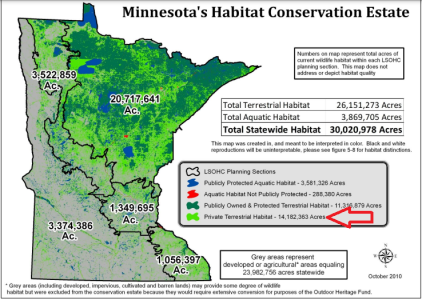SD51555
5 year old buck +
I dug up my LSOHC master plan from my bookmarks. There's info in here that everyone needs to understand. Here's what's coming. (all of these charts are available inside the linked document.
As of 2010, there were 14 million acres of private wildlife lands left in MN.

By 2034, they aim to reduce that by another 1.97 million acres just with LSOHC money. Who among us is going to give up those acres? Who is going to look down at their kids and grand kids and volunteer them to no longer be able to own their own piece of land?

If you do the math just on the 2010 and 2011 progress at eliminating private lands, they're were way ahead of their annual acres goal to hit 1.97 million. 112,000 acres/yr x 25 years = 2.8 million acres, or a 20% reduction in privately own wildlife habitat.

And this also doesn't account for other injections of money to speed this up, like when Dayton scored an extra $500 million in funding in 2017 for permanent easements. Or his 2015 score of $795 million to acquire another 100,000 acres in easements @ a cost of $8,000/ac.

 www.startribune.com
www.startribune.com
 popeswcd.org
popeswcd.org
At these rates, they'll own it all before my remains are converted to clover and rye. All I did was look at their documents to see what they thought of us, and what they intend to do with the land. Flip through that document at the top of this post. It's an eye opener.
As of 2010, there were 14 million acres of private wildlife lands left in MN.

By 2034, they aim to reduce that by another 1.97 million acres just with LSOHC money. Who among us is going to give up those acres? Who is going to look down at their kids and grand kids and volunteer them to no longer be able to own their own piece of land?

If you do the math just on the 2010 and 2011 progress at eliminating private lands, they're were way ahead of their annual acres goal to hit 1.97 million. 112,000 acres/yr x 25 years = 2.8 million acres, or a 20% reduction in privately own wildlife habitat.

And this also doesn't account for other injections of money to speed this up, like when Dayton scored an extra $500 million in funding in 2017 for permanent easements. Or his 2015 score of $795 million to acquire another 100,000 acres in easements @ a cost of $8,000/ac.

Dayton signs $500 million deal to protect rural waters
Governor Dayton Pursues $795 Million in Funding for Clean Water, Wildlife Habitat - Pope Soil & Water
Plan would partner with landowners to enroll up to 100,000 acres in water quality conservation efforts ST. PAUL, MN – Continuing his work to improve water quality and wildlife habitat, Governor Mark Dayton today submitted a $795 million proposal to the United States Department of Agriculture for...
At these rates, they'll own it all before my remains are converted to clover and rye. All I did was look at their documents to see what they thought of us, and what they intend to do with the land. Flip through that document at the top of this post. It's an eye opener.

